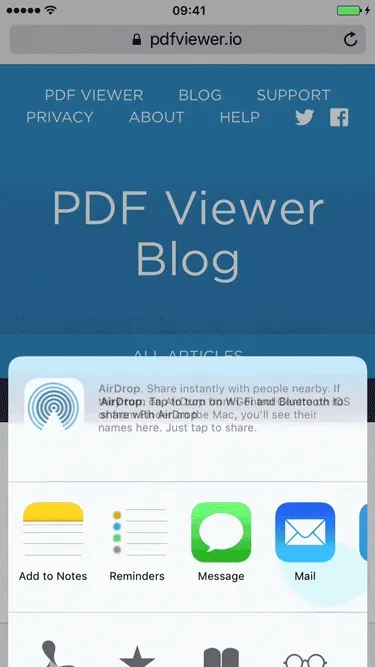The Struggle with Action Extensions
Table of contents
Extensions are becoming more and more important on iOS. At PSPDFKit we believe it is important to be a good citizen and to integrate with the system wherever possible. Two weeks ago we explained some of the gotchas when building a Today Widget, but that is not the only system integration that PDF Viewer(opens in a new tab) has to offer. To let users easily import documents, images, and websites from other apps, we offer an Action Extension.

PDF Viewer has shipped with this extension for quite a while now. Our first implementation was very straightforward, and we experienced some issues with it. Today I want to talk about what we learned from building the extension and how we solved the issues we encountered. While we chose the Action Extension for our use case, Share Extensions are, from a technical point of view, very similar and the approach of receiving content from the host application is the same. Therefore everything I am discussing here is applicable to both Share and Action Extensions.
The First Approach
I’ll skip the basics of implementing a Share or Action Extension - there are a lot of tutorials out there, plus the sample implementation you get from Xcode when creating a new Action Extension target illustrates the concept quite well.
To get everybody on the same page, let me quickly go over the most important part. The core of these extensions is one central loop that contains most of the work relating to retrieving items from the host app, iterating over these items and selecting the ones you are interested in. This is what this loop could look like in its simplest form:
BOOL imageFound = NO;for (NSExtensionItem *item in self.extensionContext.inputItems) { // Iterate over items and look for an image for (NSItemProvider *itemProvider in item.attachments) { if ([itemProvider hasItemConformingToTypeIdentifier:(NSString *)kUTTypeImage]) { // This item can be represented as image, load it [itemProvider loadItemForTypeIdentifier:(NSString *)kUTTypeImage options:nil completionHandler:^(NSData *imageData, NSError *error) { // TODO: Store data in an app group to make it accessible by PDF Viewer }]; imageFound = YES; } } if (imageFound) { break; }}While this code is a bit lengthy it looks very promising: we iterate over all the items that are shared by the host app and check if there is content in there that we can interpret. In this case, we are looking for an image.
The first questions that come to mind here are: what is an NSExtensionItem and what are NSItemProviders? Extension items are the input the extension gets from the host app. An extension item has attachments, which are a list of NSItemProvider. Attachments can be seen as the user's intent. So if the user wants to share five images, you will get five item provider. Each of these item provider can then be represented in different ways. So for example an image could be represented either by a file URL pointing to the image, by the image data itself, or maybe even textually. Therefore each item provider can have one or more items. Ideally, what you usually want to do is iterate over the item provider and pick one representation per provider to process. While the Photos app hands over multiple attachments in one item provider, Safari may hand you over multiple extension items, each of which effectively describing the same resource but in different forms. So the best approach here is to pick one extension item and process all of its item providers. (rdar://30184485(opens in a new tab))
In our example above, we try to find an item that can be represented as image. We then ask for this image and stop processing this provider's data. Once we found an image we fetch the provider's data by calling loadItemForTypeIdentifier:options:completionHandler:(opens in a new tab).
When loading the item data, a very peculiar API decision comes in to play that I have never seen anywhere else before and that will bite us in a bit: by specifying the completionHandler's first argument as NSData we also gave some information to the item provider through some Objective-C runtime magic: the item provider checks the type of the first parameter and will try to convert the underlying structure to an object of this type. So in this case it will try to convert the image into an NSData object. If it fails to do so, the first parameter will be nil.
So let's get that image as NSData and store it in our app group so that PDF Viewer can access it on its next launch. Testing this with Safari yields exactly the result we want. The image is loaded, we store it, and the code in the main app picks it up and shows it in the list of files. So we are done with our extension right? Everything is working as expected, great job! We pat ourselves on the back, commit everything and enjoy our quick success. 😇
From Objective-C to Swift
Sadly someone dared to try this extension on a photo in the Photos app – who would have thought? Guess what? When executing the same code that works perfectly well when tested with Safari through a share intent from Photos instead, our completionHandler's first parameter is nil. A post in the Apple Developer Forum(opens in a new tab) suggests that this is just an issue in Swift, but I find this failing in Objective-C as well. What's going on there? Let's put our Objective-C code aside and look at the same implementation in Swift:
for item in context.inputItems as! [NSExtensionItem] { // Iterate over items and look for an image guard let attachments = item.attachments else { continue } for itemProvider in attachments as! [NSItemProvider] { if itemProvider.hasItemConformingToTypeIdentifier(String(kUTTypeImage)) { // This item can be represented as image, load it itemProvider.loadItem(forTypeIdentifier: String(kUTTypeImage), options: nil, completionHandler: { (imageData, error) in guard let imageData = imageData as? Data else { return } // TODO: Store data in an app group to make it accessible by PDF Viewer }) } }}In Swift we can’t specify a custom type for the first parameter of the completion handler, because the type system ensures the closure type matches the API(opens in a new tab), which declares the type as (NSSecureCoding?, Error!) -> Void. So in Swift you need to take the object as what it actually is: a random object that conforms to NSSecureCoding. This is all the API promises us. You can then cast this object e.g. to Data. This, of course, can fail, because the object may not be of type Data. However, while in Objective-C this all happens somewhere in the framework and is hidden from us, in Swift we still see the actual object in the debugger. Looking at this, we'll find that the object is of type URL instead of type Data.
The problem here is that while the type of the item is kUTTypeImage, nobody guarantees that you will actually get the image data itself. Instead the Photos and Messages apps will provide you with a URL pointing to that very image. While my gut tells me that if it is a URL to a local file, the type should actually be kUTTypeFileURL instead of kUTTypeImage, Safari seems to be the only app that handles it this way and if that would be documented somewhere, it would indeed make sense to always get a file URL while the type identifier specifies what is actually in the file. (rdar://29924023(opens in a new tab))
Another problem here is, that loadItem(forTypeIdentifier:, options:, completionHandler:), is designed as asynchronous API. Once you decided to actually load an item from a provider, you usually break out of the inner loop that checks an item provider's data. So when the completion handler is called with a nil value, it is quite complicated to reiterate over an extension item’s providers and check for other, more suitable items.
To make this work, we changed our code to first try to cast to a URL and if that fails we cast to a data blob. We prefer a URL here because a URL is the better choice when it comes to resources as we don't need to load the whole thing into memory. In fact we first check if the extension item has a provider that has items conforming to kUTTypeFileURL before trying other types like image or PDF. Surprisingly, a picture from the Photos app or the Messages app does not have such a provider, even though the underlying data structure is of type URL.
If you are writing your extension in Objective-C, you can do the same thing. Even though the documentation says "The type information for the first parameter of your completionHandler block should be set to the class of the expected type.(opens in a new tab)" you can set the parameter to be of type id<NSObject, NSSecureCoding> and you will get an object that you can then analyze with the help of isKindOfClass:.
Copying the File
Now that we figured that if we receive a URL instead of Data in many cases, our life is a bit easier. We can just use FileManager and copy over the image from the location in the URL into our app group where our extension as well as our app can then access it. Or – can we? When I said "We prefer a URL here [...] as we don't need to load the whole thing into memory", that was a theoretical statement. Let’s see what happens if we actually try to copy an image into our app that was shared by a URL from the Messages.app:
SandboxViolation: ImageSharing(5854) deny(1) file-read-metadata /private/var/mobile/Library/SMS/Attachments/eb/11/A33F6838-EE4F-4794-AE92-7FEE492CF278/IMG_2417.PNGWhile our extension is now working fine in Safari and Photos, somehow the file we are getting from the Messages app can not be copied. (rdar://29918507(opens in a new tab)) After digging around a bit, I found that we can't copy the image, but interestingly what we can do is this:
let data = Data(contentsOf: fileURL)data.write(to: targetURL, atomically: true)That sounds awfully familiar to what I was trying initially. We now have a URL that we open as Data and write that data blob into our app group. We could minimize the needed memory footprint by opening the file as memory mapped data, but we still have a Data object in memory that has the potential to shoot our extension out of the sky, and memory is far more limited in an extension like this than it is in your app. As this whole approach is not only valid for images but could also happen with PDFs, in theory a user could open our extension with a PDF file that is multiple gigabytes in size. That's not the kind of content you want to see in a Data instance. So we are looking for a way to open a file and copy its content over to a new location, piece by piece.
It may sound silly, but I decided to move over to InputStream and OutputStream and simply use one of each to copy the file over to its new location in chunks of 1 kB.
NSInputStream *input = [NSInputStream inputStreamWithURL:fileURL];NSOutputStream *output = [NSOutputStream outputStreamWithURL:targetURL append:NO];
[input open];[output open];
NSInteger bytesRead = 0;uint8_t buffer[1024] = { 0 };while ((bytesRead = [input read:buffer maxLength:1024])) { if (bytesRead > 0) { [output write:buffer maxLength:bytesRead]; } else { break; }}
[input close];[output close];guard let input = InputStream(url: source), let output = OutputStream(url: target, append: false) else { throw RequestError.cantCreateStream }
input.open()output.open()
defer { input.close() output.close()}
let chunkSize = 1024var buffer = [UInt8](repeating:0, count:chunkSize)
var bytesRead = input.read(&buffer, maxLength: chunkSize)while bytesRead > 0 { let bytesWritten = output.write(buffer, maxLength: bytesRead) if bytesWritten != bytesRead { throw output.streamError ?? RequestError.streamWriteError } bytesRead = input.read(&buffer, maxLength: chunkSize)}UIAppearance
After I covered the issues we had with the actual content, there was one more issue we discovered recently with our extension. When invoked through some apps, there seemed to be an issue with the tintColor.

Calling setTintColor: did not do anything, neither did overriding setTintColor:, as this was never called by the system. After some digging we found that this is not a bug but actually a feature. By default an extension completely picks up the UIAppearance settings from its host app. In theory that lets you build an extension that feels like it is part of the host application. This sounds great, but the problem with that is that it also is a lot of work. A host app might set its background color to black and its text color to white. This gives your extension a very different look, but as long as everything is configured through appearance proxies, this would work.
But a host app also may only set the tint color to dark blue like in the image above, but does not set anything else. Or it may not set its tintColor through UIAppearance at all, which would leave your extension with the default blue color even though the host app might have a different tint color. There are countless options and possibilities a host app could configure itself. Good luck with adapting to all the possibilities. Just to get the example above working, we would need to detect that there is a tint color defined through UIAppearance by the host app. We then would need to analyze that color and detect that the contrast to our blue background is very low and then alter the background color. Now imagine an app that the host also defines a different tint color for the navigation bar, but maybe not the navigation bar's barTintColor.
I don't think there is any way to make that work in all cases. It depends too much on what the host app does. You could argue that the host app needs to ensure it configures extensions correctly, and even though this is true in some way, it most likely will still be you who gets the angry customer support requests because your extension shows white text on a white background. Luckily there is an entry – undocumented at the time of writing – that you can add to your extension's Info.plist to opt out of this behavior: in the NSExtension dictionary you can specify the key NSExtensionOverridesHostUIAppearance, make it of type Boolean and set it to YES. This prevents forwarding of UIAppearance settings from the host app to your extension and you can design your extension's UI as if it was a stand alone application. This is only available as of iOS 10 though, so be aware that your extension might still look wrong in iOS 9.
Conclusion
Be very careful with the provider types you request and the data structures you receive. An image might be shared as kUTTypeFileURL or it might be shared as kUTTypeImage and you will receive either a URL or a Data object. You will also find applications that give you more details and share an image as kUTTypeJPEG or kUTTypePNG, so keep this in mind too.
We even had cases where our extension was triggered with no item providers at all. So make sure you have appropriate error handling everywhere – 'what can go wrong, will go wrong' is a very good mantra when working on any kind of extension that deals with data from unknown host apps – keep that in mind at all time.
The result of this struggle is an extension that can hopefully handle all kinds of scenarios it may experience in the wild. You can check it out in our app – it's free(opens in a new tab)!
While working on this, in addition to the Radars already mentioned, I also filed the following:
- Photos.app advertises live photo to action extensions which then can't be accessed (rdar://29924331(opens in a new tab))
- Messages.app advertises live photos to action extensions as arbitrary image (public.image) and is sharing a jpeg (rdar://29924679(opens in a new tab))







